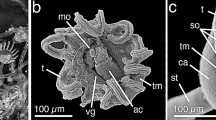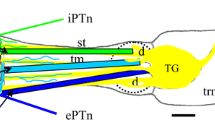Summary
Free nerve endings are abundant in the distal epithelium of the tentacles of Arion ater Four ultrastructurally distinct types of ending are identified from serial sections. The Type 1 free nerve ending bears a distal cup from which arise short microvilli and a few cilia. Different free nerve endings in this grouping may show considerable individual variation. The Type 2 free nerve ending bulges slightly at its distal surface. From its surface arise short microvilli and numerous cilia. The Type 3 and Type 4 free nerve endings are unusual since they bear only long microvilli, cilia being absent. In the Type 3 these microvilli are few. In the Type 4 they are numerous and form a cluster at the dendrite tip. In the distal epithelium of the inferior and superior tentacles approximately 10% of the free nerve endings are Type 1 8% Type 2 and 80% are Type 3, Type 4 being rare. It is tentatively suggested that the Type 1 ending is mechanoreceptive and the Type 3 ending is chemoreceptive.
Similar content being viewed by others
References
Altner, H., Müller, W., Brachner, I.: The ultrastructure of the vomero-nasal organ in reptilia. Z. Zellforsch. 105, 107–122 (1970)
Bannister, L. H.: Fine structure of sensory endings in the vomero-nasal organ of the slow worm Anguis fragilis. Nature (Lond.) 217, 275–276 (1968)
Barber, V. C.: The fine structure of the statocyst of Octopus vulgaris. Z. Zellforsch. 70, 91–107 (1966)
Barber, V. C.: The structure of mollusc statocysts, with particular reference to cephalopods. Symp. Zool. Soc. Lond. 23, 37–62 (1968)
Barber, V. C., Dilly, P. N.: Some aspects of the fine structure of the statocysts of the mollusc Pecten and Pterotrachea. Z. Zellforsch. 94, 462–478 (1969)
Barber, V. C., Wright, D. E.: The fine structure of the eye and optic tentacle of the mollusc Cardium edule. J. Ultrastruct. Res. 26, 515–528 (1969a)
Barber, V. C., Wright, D. E.: The fine structure of the sense organs of the cephalopod mollusc Nautilus. Z. Zellforsch. 102, 293–312 (1969b)
Bedini, C., Mirolli, M.: The fine structure of the temporal organs in the pill millepede, Glomeris romana Verhoeff. Monit. zool. ital. (N.S.) 1, 41–63 (1967)
Boeckh, J., Kaissling, K. E., Schneider, D.: Insect olfactory receptors. Cold Spr. Harb. Symp. quant. Biol. 30, 263–280 (1965)
Brown, H. E., Beidle, L. H.: The fine structure of the olfactory tissue in the black vulture. Fed. Proc. 25, A 786, 329 (1966)
Bullock, T. H., Horridge, G. A.: Structure and function in the nervous system of invertebrates, vol. 11, part 1 V: The mollusca; chapt. 23, p. 1283–1386. San Francisco and London: Freeman 1965
Crisp, M.: Structure and abundance of receptors of the unspecialized external epithelium of Nassarius reticulatus (Gastropoda, Prosobranchia). J. mar. biol. Ass. U.K. 51, 865–890 (1972)
Demal, J.: Essai d'histologie comparée des organes chémorécepteurs des Gastéropodes. Mém. Acad. roy. Belg. 29, 5–82 (1955)
Graziadei, P.: Electron microscopy of some primary receptors in the sucker of Octopus vulgaris. Z. Zellforsch. 64, 510–522 (1964)
Graziadei, P., Bannister, L. H.: Some observations on the fine structure of the olfactory epithelium of the domestic duck. Z. Zellforsch. 80, 220–228 (1967)
Graziadei, P., Tucker, D.: Vomeronasal receptors in turtles. Z. Zellforsch. 105, 498–514 (1970)
Hanström, B.: Über die sogenannten Intelligenzsphären des Molluskengehirns und die Innervation des Tentakels von Helix. Acta zool. (Stockh.) 6, 183–215 (1925)
Kittel, R.: Untersuchungen über den Geruchs- und Geschmacksinn bei den Gattungen Arion und Limax (Mollusca: Pulmonata). Zool. Anz. 157, 185–195 (1956)
Knapp, H. F., Mill, P. J.: The fine structure of ciliated sensory cells in the epidermis of the earthworm Lumbricus terrestris. Tissue and Cell 3, 623–636 (1971)
Lane, N. J.: Microvilli on the external surfaces of gastropod tentacles and body walls. Quart. J. micr. Sci. 104, 495–504 (1963)
Millonig, G.: Advantages of a phosphate buffer for OsO4 solutions in fixation. J. appl. Phys. 32, 1637 (1961)
Moquin-Tandon, A.: Mémoire sur l'organe de l'adorat chez les Gastéropodes terrestres et fluviatiles. Ann. Sc. nat. zool. 15, 151–158 (1851)
Murray, R. G.: Ultrastructure of taste receptors. In: Handbook of sensory physiology, IV Chemical senses 2, Taste, p. 31–50, ed. Beidler, L. M. Berlin: Springer (1971)
Reese, T. S., Brightman, M. W.: Olfactory surface and central olfactory connections in some vertebrates. In: Ciba Foundn. Symp. on: Taste and smell in vertebrates, p. 115–150, eds. Wolstenholme, G.E.W., and Knight, J. London: Churchill 1970
Renzoni, A.: Osservazioni istologiche, istochimiche ed ultrastrutturali sui tentacoli di Vaginulus borellianus. (Colosi), Gastropoda. Soleolifera. Z. Zellforsch. 87, 350–376 (1968a)
Renzoni, A.: Olfactory epithelium of gastropods. In: Electron microscopy. Proc. 4th Europ. Region. Conf. Rome, 1968, vol. 2, p. 567–568, ed. Bocciaretti, D. S. (1968b)
Retzius, G.: Das sensible Nervensystem der Mollusken. Biol. Untersuchungen N. F. 4, 11–18 (1892)
Rogers, D. C.: Surface specializations of the epithelial cells at the tip of the optic tentacle, dorsal surface of the head and ventral surface of the foot in Helix aspersa. Z. Zellforsch. 114, 106–116 (1971)
Schulz, F.: Bau und Funktion der Sinneszellen in der Körperoberfläche von Helix pomatia. Z. Morph. Ökol. Tiere 33, 555–581 (1938)
Slifer, E. H., Sekhon, S. S.: The dendrites of thin-walled olfactory pegs of the grasshopper (Orthoptera, Acrididae). J. Morph. 114, 393–410 (1964)
Storch, V., Welsch, U.: Über Bau und Funktion der Nudibranchier-Rhinophoren. Z.Zellforsch. 97, 528–536 (1969a)
Storch, V., Welsch, U.: Über Aufbau und Innervation der Kopfanhänge der prosobranchen Schnecken. Z. Zellforsch. 102, 419–431 (1969b)
Thornhill, R. A.: Ultrastructure of the olfactory epithelium in the lamprey, Lampetra fluviatilis. J. Cell Sci. 2, 591–602 (1967)
Thurm, U.: Steps in the transducer process of mechanoreceptors. In: Invertebrate receptors. Symp. zool. Soc. Lond. 23, 199–216 (1968)
Vinnikov, Y. A.: Structural and cytochemical organization of receptor cells in sense organs in the light of their functional role. Fed. Proc. 25, A786, 329 (1966)
Wallis, D. I., Wright, B. R.: The tactile sense of the tentacles of the common slug. J. Physiol. (Lond.) 213, 8P (1970)
Welsch, U., Storch, V.: Über das Osphradium der prosobranchen Schnecken Buccinum undatum L. und Neptunea antiqua (L). Z. Zellforsch. 95, 317–330 (1969)
Wondrak, G.: Elektronenoptische Untersuchungen der Körperdecke von Arion rufus L. (Pulmonata). Protoplasma (Wien) 66, 151–171 (1968)
Wright, B. R.: Sensory structure and function in Arion ater (L.) tentacles. Ph. D. thesis University of Wales (1972)
Wright, B. R.: Sensory structure of the tentacles of a slug, Arion ater (Pulmonata, Mollusca) 1. The ultrastructure of the distal epithelium, receptor cells and tentacular ganglion. Cell Tiss. Res. 151, 229–244 (1974)
Zylstra, U.: Distribution and ultrastructure of epidermal sensory cells in the freshwater snails Lymnaea stagnalis and Biomphalaria pfeifferi. Neth. J. Zool. 22, 283–298 (1972)
Author information
Authors and Affiliations
Additional information
The authors wishes to thank Dr. D. K. Roach and Mr. T. Davies for their helpful advice and Drs. D. Graham and U. Zylstra for proof-reading the manuscripts. This research was carried out during the tenure of an S.R.C. research studentship.
Rights and permissions
About this article
Cite this article
Wright, B.R. Sensory structure of the tentacles of the slug, Arion ater (Pulmonata, Mollusca). Cell Tissue Res. 151, 245–257 (1974). https://doi.org/10.1007/BF00222226
Received:
Issue Date:
DOI: https://doi.org/10.1007/BF00222226




